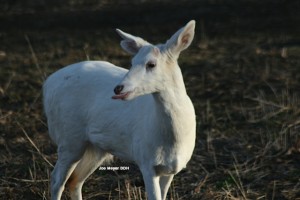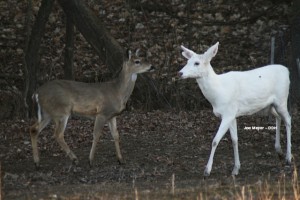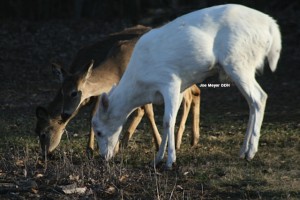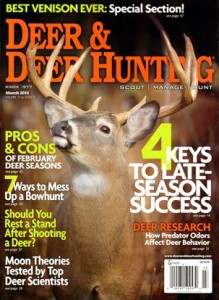
Not all deer are born equal. Especially the ones that stand out like beacons in the night! Here’s a look at what just might be one of the most fascinating deer roaming southeastern Wisconsin this spring.
by Daniel E. Schmidt
These very cool photos today come compliments of my niece and her husband, Andrea and Joe Meyer, of Harford, Wis. Yep, that’s right, what they spotted out their kitchen window was a white-tailed deer like no other.
Joe writes:
“A neighbor stopped by today and asked if I had seen an albino deer lately. He had just seen it near the road and it was heading toward our house. We then saw it plain as day several hundred yards away initially with five other deer and it wandered around the fields and woods far away for about an hour.
“Then they all decided to follow the woodline right near our house, getting 30 feet away at one point. They then moved along through the woods. Nathaniel (our toddler) was so excited Andrea had to hold him back from banging on the window so I could take these pictures!”
I can’t blame little Nathaniel one bit for being excited. After all, what he was seeing was extremely rare. According to one scientific study, only one in 35,986 deer are albinos. If, in fact, what he saw is a true albino. More on that later.
We’ve been documenting all kinds of color traits in whitetails for parts of five decades here at Deer & Deer Hunting, and here’s what we know for certain from deer researchers like Michigan’s John Ozoga:
1. Hair color in the normally brown whitetail might vary from white, brown, gray and black. It might range from all white (albinism) to partially white (piebald) to all black (melanistic).
2. Albinos have a characteristic pink skins and pure white coat. Their irisies of their eyes are usually pink, but are sometimes a pale blue. Although rare, albinos occur more frequently than melanistic deer.
3. Not all white deer are albinos, and there is no such thing as a “partial albino.”
 4. Because albinism is a recessive genetic trait, inbreeding can increase its incidence. True albinos have little to no melanin in their bodies. Hence, their hair is white because it lacks pigment. The skin appears to be pink because the flowing blood shows through the deer’s pale skin.
4. Because albinism is a recessive genetic trait, inbreeding can increase its incidence. True albinos have little to no melanin in their bodies. Hence, their hair is white because it lacks pigment. The skin appears to be pink because the flowing blood shows through the deer’s pale skin.
As evidenced in the photos and story that lead off this blog, seeing an albino in the wild is cause for excitement and, as a result, many states have drafted laws protecting these deer. Unfortunately, such regulations fly in the face of sound wildlife management. Because of their odd biological condition, albinos are, in fact, genetically inferior stock. Allowing them to breed allows for the genes to re-circulate the whitetail gene pool. Because of the lack of melanin in their eyes to block light, albinos have a very difficult time seeing in bright sunlight. Furthermore, they are also more prone to skeletal maladies like dysplasia. As a result, albino deer often die at a much earlier age than normal whitetails.
Back to the one unanswered question about the doe in these photographs. Is it a true albino? Maybe. But maybe not. According to deer researchers, a true albino white-tailed deer will have pink or blue eyes and white hooves. From Joe’s photos, it appears this deer has normal-colored hooves and dark eyes.
What would this deer be if it wasn’t an albino? It is my educated guess that this deer would be quite the extreme example of a piebald in that situation. There is another category of white-tailed deer that are considered “all white” — with no relation to albinos or piebalds — but they have not been very well documented in the Midwest. There is a pocket of these deer in Seneca, NY, but that is that’s the topic of another blog.
Regardless, at the end of the day, I’d call Joe, Andrea and Nathaniel’s encounter “once in a lifetime!”

Learn more about deer behavior and biology so you can be become a well-rounded hunter! Get America’s first and foremost whitetail source delivered to your door; laptop; phone or tablet each month!







